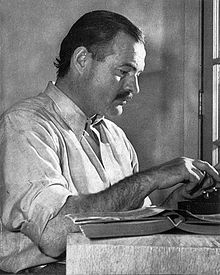Organizers Credit Depth of Hemingway Symposium for Turnout

More than 400 people attended the Hemingway Symposium, Oct. 22, and organizers credit the Hemingway name, but also the event’s multi-dimensional attraction, to its popularity.
Dr. Matthew Nickel, professor of English and one of the organizers, estimated that 40 people attended the student paper presentation, 80 took part in the Hemingway scholar lectures, and more than 350 listened to the talk of Valerie Hemingway, the famous author’s daughter-in-law.
“The simple answer for the popularity of the event is Hemingway,” Nickel said. “There’s right now a huge resurgence in Hemingway. People are interested in him. In the last five years there have been three major movies that have come out either based on his work or with Hemingway as a character.”
Rita Molino, administrative assistant to the Dean of the College of Arts and Sciences and the humanities, said another draw was Hemingway’s daughter-in-law.
“I do believe that the Hemingway name, and the fact that Valerie Hemingway, who had traveled with Ernest Hemingway, made a big difference as far as the popularity of the event,” said Molino.
The event also drew attendees who supported friends and family presenting during the student papers event.
Rachel Hoover, a sophomore English major, came to watch her friend present.
“I went to support my friend, Bailey Waltman, who was reading an essay at it. I then stayed for the rest of the event because it was really interesting. For one of the events, I sat in front of Valerie Hemingway, so I hope I didn’t block her view with my big hair,” said Hoover.
Like Hoover, Christine Zopf, a senior business administration and English major, attended for personal reasons, but stayed due to the quality of the event.
“I went to the Hemingway Symposium because my best friend Leah, who graduated, was coming back for the Symposium and I wanted to spend time with her. Overall, I had a great time and I especially liked Valerie Hemingway’s speech. She was very captivating and riveting,” said Zopf.
Nickel added that professionals and scholars who read Hemingway came to learn from four leading Hemingway scholars, a key part of the event. The Symposium also marked the opening of the “Hemingway and the Veneto” art display in the Pauly Friedman art gallery. The keynote speaker, Valerie Hemingway, interested those who just wanted to learn more about the author, he said.
“Everybody’s going to come for different reasons. You’re going to get people who are going to come for the students while others are going to come with a scholarly interest maybe like professionals who read Hemingway a little bit more than just for pleasure, and then you’re going to have people who say ‘Oh, Valerie Hemingway, let’s go see that.’ And then there are the art people who come out for the gallery,” said Nickel.
Some teachers offered extra credit to students who attended while others, such as Nickel, simply invited students.
Molino believes turnout at campus events depends upon multiple factors, especially schedule conflicts.
“I do believe that we’ve had a good turnout for many of the other events that we’ve had on campus, but I’ve learned while working on events throughout the few years that I’ve been here is that it does depend on the speaking engagement, what type of an event it is, and if at the same time there are other events going on on campus that may conflict with the schedules of the students, faculty and staff,” said Molino.
But the main reason for the success of any event, Molino said, is the cooperative effort of many people.
“With regard to this one, it was a very big cooperative effort on the part of a lot of people in order for this event, and all the other events, really, to have the impact that it did,” said Molino.
She also worked with the university Public Relations and Marketing departments to spread the word to the public. Donna Pasatko, art gallery director, worked to prepare the gallery, and the grounds people did the set up, she said. Perhaps most important to the program’s success was Barbara Soyka, who sponsored the symposium.
“These people and many others have been so generous of their time and consideration, and I believe that the ultimate goal really is that we are trying to show the public as well as the university community and prospective students that we not only teach students in the classroom, but also provide other areas of instruction and enlightenment by providing different events and panels that students can become involved in. These events give students a greater understanding going forward in their lives. So it isn’t just classroom instruction,” said Molino.
